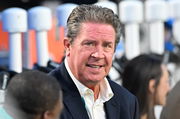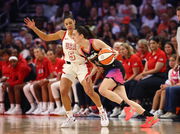
Imago
Credits: Imagn

Imago
Credits: Imagn
Isn’t it heartbreaking when a perfectly good candidate loses a much-deserved spot? Not because they lack in any manner, but simply because there’s no vacancy. We’ve all been there at some point, some more than others. And women NCAA candidates? The most. The season always kicks off with so much hope. Fans unfailingly mark their calendars for draft night while being eager to see their favorite NCAA stars transition to the WNBA.
Watch What’s Trending Now!
But reality hits fast. Training camps wrap up, final rosters get posted, and suddenly, waiver announcements flood the media. Players who were tournament standouts just weeks earlier find themselves cut. It just serves as a harsh reminder of how competitive this league is, mostly due to its size. Enter: a proposal for WNBA G-League. Let’s dive deep into the need, plan, and benefits of it.
ADVERTISEMENT
Why It Matters?
The WNBA doesn’t need a minor league for just one reason. Between strict roster limits and underdeveloped talent pathways, a widening structural gap exists that has only grown deeper over time.
Roster Saturation
The WNBA’s tight roster system demands that teams carry only elite talent; there’s space for only the “best of the best.” With just 13 teams and rosters capped at 12 players (often reduced to 11 due to salary caps), the league offers only 156 spots. Unlike the NBA, which has 30 teams and 15 roster spots each (450 total), this setup leaves little to no room for emerging talent.
ADVERTISEMENT
Even after getting drafted, a player is far from secure; their spot on the roster is never guaranteed. And for those who do make it, they often face tension over playing time and defined roles. This challenge does not limit itself to the court, where they are cobbled into 10-minute roles, but follows them to the locker rooms as well. Take Li Yueru, for example, the Seattle Storm center who had to seek a trade after joining a log-jammed frontcourt.
Top Stories
“RIP”: Prayers Pour In as Tom Brady’s Raiders Struck by Tragedy

Footage Surfaces of Florida Police Arresting NASCAR Veteran Over Disturbing Public Misbehavior

“Rest in Peace”: Prayers Pour In From Dan Marino as Dolphins Legend Mourns Tragedy in South Florida Football

Caitlin Clark Shows Concerning Signs vs. Kelsey Plum During USA Camp Debut, per National Reporter

“NFL Was Crying”: Maxx Crosby Says League Forced Him to Remove Shoes Honoring His Daughter

Chiefs QB Patrick Mahomes Loses Faith in Kansas City With Cowboys Decision as FOX Host Calls Out Clark Hunt’s Ownership

“I came to America only for one reason, to play basketball… We have the best post player in the world, we have four post players, and I don’t feel I have enough time,” Yueru said. Her frustration perfectly captures how, in this win-now environment, cultivating raw talent often takes a backseat to choosing ready-to-contribute stars. And it’s not just rookies feeling the pressure. Even seasoned players aren’t safe from the WNBA’s relentless competition.
ADVERTISEMENT
Just ask Layshia Clarendon, a 10-year WNBA veteran who made the L.A. Sparks’ 2023 opening-day roster after a full-year hiatus. Despite being an All-Star in 2017 and playing for five different franchises, the Minnesota Lynx waived Clarendon in 2022. Later, she had to earn her way back through a tryout where just one wrong move could have cost her everything.
Undermining Rising Domestic Talent
Every WNBA draft delivers a wave of top NCAA talent, but many never get a real shot even after being there. Historically speaking, the first-rounders usually make the cut, but the second and third-round picks frequently don’t survive the training camp. Of the 36 players drafted across three rounds, only 15 of them made a roster in 2023, and just 17 did in 2022. While this season saw the numbers boost to 20, the reality was still painfully clear as unexpected cuts emerged.
ADVERTISEMENT
According to Yahoo Sports, multiple college stars were waived shortly after being drafted. Maryland’s Shyanne Sellers, the No. 17 overall pick, was brutally waived twice. First by the Golden State Valkyries on May 3, then again by the Atlanta Dream on May 12. The Indiana Fever cut Bree Hall, a second-round pick and two-time NCAA champion from South Carolina. The Las Vegas Aces waived Harmoni Turner, the Ivy League Player of the Year and a third-round pick out of Harvard.
Such decisions leave many promising players with either nowhere to go or having to leave the Country to play overseas. Their careers stall at the doorstep of the national pros, not because of a lack of talent, but because of a lack of opportunity.
ADVERTISEMENT
No Clear Path Like NBA/MLB
The WNBA currently lacks an organized development structure that is comparable to systems like the NBA’s G-League or MLB’s minor leagues. These act like foolproof models for nurturing professional talent. The G-League specifically prepares players for the NBA with identical rules. Like a 24-second shot clock, an 8-second backcourt rule, and four 10-minute quarters (just two minutes shorter than NBA games). This consistency helps the future NBA prospects adjust to professional pace, physicality, and systems, coming right out of college or even before that. The G-League Ignite program, for example, served as a pro pathway for prospects like Jalen Green, bypassing college to prepare for the NBA.
WNBA hopefuls deserve the same opportunities; in fact, they need them even more. Biological studies suggest that women in high-intensity sports are more prone to injuries. And considering that rookies often enter high-stakes games with minimal professional experience, they face intense pressure, physical demand, and hence, increased risk of injuries. Take Cameron Brink’s example, who had to be sidelined after playing just 15 games. A developmental league would offer more court reps, allowing players to build skills in a less pressured environment.
Also, as mentioned earlier, bench players in the WNBA often see sporadic action, disrupting chemistry. A G-League-style system would let prospects play 20-30 minutes per game, mastering systems and roles before WNBA debuts.
ADVERTISEMENT
WNBA’s Next Best Move
Let’s outline a pilot proposal for a WNBA developmental league, an elite counterpart to the NBA’s G-League.
The WNBA should implement an 8-team pilot program to address its current challenges, where an existing WNBA franchise would affiliate with each of these eight minor league teams. They would function as a true developmental system for rookies, undrafted players, and bench talent, and the season would run parallel to the WNBA schedule with a compact 6-8 game slate. Adding to that, everything should be strategically timed to enable smooth call-ups when injuries or performance demands arise in the pros.
ADVERTISEMENT
These teams should be placed in college basketball hotbeds, such as Iowa City (University of Iowa), Columbia (University of South Carolina), and Eugene (University of Oregon). These locations would offer built-in advantages to the young women, including ready-to-use facilities. This approach would create much-needed natural continuity for fans and maximize engagement.
It would also establish a domestic alternative to overseas play, building on the success of models like Athletes Unlimited and Unrivaled. While international opportunities would remain available, this system would give players more options tailored to their aspirations.
Regarding formalities, the league should implement NBA-style two-way contracts to allow seamless movement between teams without salary cap issues. This structure would give franchises roster flexibility while effectively developing future talent. It’s a win-win for both the competitive teams and the prospects.
ADVERTISEMENT
All of this could become reality with owner investment. Rather than viewing this as a cost, stakeholders should see it as a growth opportunity with long-term returns. Ultimately, a WNBA G-League isn’t just a roster fix; it’s a sustainable ecosystem that will create fair opportunities for multiple stakeholders, deepen fan connections, and position the league for long-term growth.
A Summary of the Benefits
Monetary & Economic
- An increase in the franchise’s value
- Easy entry point for the newer investors
- Stimulation of local economies
- Greater national basketball revenue (domestic options instead of overseas)
Health, Well-being & Career Security
- Injury prevention
- Increased earning potential
- Reduced burnout
- A boost in confidence
Equity & Representation
- Democratized access to pro sports
- Creation of equity with male counterparts
- Empowerment of women’s sports at all levels
Finally, at its core, the WNBA doesn’t need a miracle, but just a coordinated effort, clear vision, and real commitment from franchise owners. The foundation for a development league already exists through proven models like the NBA’s G-League. Just with some action, all these potential benefits could become a reality rather than being theoretical concepts on paper.
ADVERTISEMENT
ADVERTISEMENT
ADVERTISEMENT

